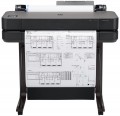Placement
-
Floor. Plotters designed for installation directly on the floor, on special stands; the availability of a stand for such a device is mandatory, because it carries various auxiliary equipment – particularly, a basket for completed prints. The floor models are predominantly advanced models, which are distinguished by their large weight and size. This option is convenient because the plotter does not require additional surfaces such as tables for installation. On the other hand, such a unit can create inconvenience in tight room where there is little free space on the floor. Also note that some floor models are not equipped with stands, they must be purchased separately.
-
Desktop. Plotters designed to be placed on a table, workbench, or other similar stand. This installation is good in constrained conditions, because it does not require floor space. On the other hand, it imposes some restrictions on weight and dimensions, which is why desktop plotters are usually designed for relatively small paper sizes - A2, less often A1 (see above).
Sheet printing time
Approximate time taken by the plotter to print one sheet.
This indicates for the paper size that the machine was originally designed for (see "Paper Size"). And it is approximate because it is usually given for optimal or almost optimal printing conditions: low quality and resolution, relatively simple images, etc. So the actual print time of the sheet may differ from the claimed one in one direction or another, depending on the operating parameters — starting from the mentioned quality and resolution to the type of media. However, according to the figures indicated in the specs, it is quite possible to evaluate different models and compare them with each other: the difference in the claimed time, usually, will proportionally correspond to the difference in the actual printing speed.
It is also worth noting that this time is usually indicated by the duration of the printing process itself — from the capture of the sheet by the feeder to the output of the completed print from the device. Interruptions inevitably occur between printing individual sheets, so that the total printing time is longer than the printing time of a sheet multiplied by the number of sheets. For example, a device with a time consumption of 36 sec per sheet theoretically should print about 100 sheets per hour (1 h = 3600 s, 3600/36 = 100), but in fact such a plotter usually produces about 70 – 75 sheets in this time.
Drop volume
The smallest drop volume of ink that can be produced by the printhead of an inkjet or similar plotter (see "Product Type").
This parameter is directly related to the print resolution (see “Maximum resolution”): the more dots per inch, the smaller the separate dots and, accordingly, the drops should be. At the same time, models with the same dpi number may differ slightly in this parameter. In such cases, it should be assumed that a smaller droplet volume potentially provides better print quality, with more accurate reproduction of fine lines and borders between individual areas of the image, however, such features accordingly affect the price of the device.
Max. roll diameter
The largest roll diameter that can be installed in a plotter with roll printing (see above). This parameter is useful primarily for the selection of media: the material of the same width can be produced in rolls of different diameters.
Number of rolls
The number of rolls that can be installed in a plotter that can print from such media at one time (see above).
Most often, such models are made for one carrier, however, there are also more advanced units — for
2 or more rolls(in some cases this number reaches 4). The meaning of this functionality is that you can simultaneously use media of different sizes (for example, A1 and A2) or/and types (for example, glossy and matte paper) while printing. Of course, you can only print on one material at a time; however, the presence of multiple rolls allows you to switch between them simply through the settings of the plotter, without fiddling with changing media.
Paper grammage (min)
The lowest grammage of paper that the plotter can print normally on. Grammage is expressed in grams per square metre; accordingly, the more dense the paper, the thicker it is, and the greater the difference between the minimum and maximum paper grammage, the greater the range of materials the plotter can operate with.
The use of materials that are too thin can lead to a number of troubles: multi-sheet picking, creasing, jamming, etc. Therefore, if you plan to use low-grammage paper, you should pay special attention to this characteristic.
Paper grammage (max)
The highest paper grammage that the plotter can handle normally. For details about grammage, see "Paper grammage (Min)"; and you should pay attention to its maximum value if you plan to use thick materials. Do not try to print on more dense media than it is specified in the specs of the device: even if the plotter can handle such paper normally, it can cause serious damage.
Cartridge model
Models of cartridges used in the plotter. With this info, you can easily find original consumables for the device.
Noise level
The maximum noise level produced by the plotter during operation. The lower this indicator, the less inconvenience to others the device will create. At the same time, in modern plotters, the noise level usually does not exceed 60 dB, which is comparable to a TV set at an average volume; and many of them do not "reach" even up to 50 dB, corresponding to a quiet conversation at a distance of 2-3 m. And if we also take into account the fact that plotters are usually used in industrial premises, then we can say that in most cases this indicator does not play a significant role.
